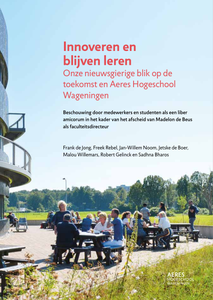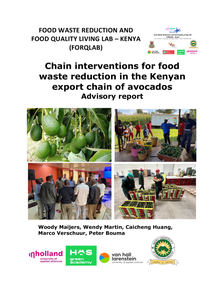This lessons learned report gives an overview of the output and results of the first phase of the REDUCES project. The introduction states the relevance of combining a policy approach with business model analysis, and defines the objectives. Next, an overview is given of circular economy good business practices in the regions involved. Examining these business practices helped to define the regional needs for circular economy policy. This business approach proved to be a solid base for developing regional circular economy action plans, the last chapter of this report.
DOCUMENT

This short paper describes the first prototyping of a self-evaluation process of Curriculum Agility at a Faculty of Technology in Sweden. The process comprises guided, semi-structured, individual interviews at different organisational levels within the faculty, a joint narrative based on those interviews, prioritizing development strategies per level, and jointly mapping them on importance and implementation time. The self-evaluation is part of and based on the research on the principles of Curriculum Agility. The results show the interplay in timely curriculum change for futureproof engineering education between the teaching staff, the systems and the people who control the systems. The self-evaluation brings together the different perspectives and perceptions within the faculty and gives insight in how those affect he willingness towards and occurrence of curriculum development. This work in progress indicates how doing such a qualitative self-evaluation paves the road for transparent strategic dialogues on a holistic level about what to give attention and organize differently.
DOCUMENT

Based on the theory of embodied cognition we developed NOOT, at tangible tool that allows marking audio-moments during creative sessions. A detailed analysis of using NOOT in practice lead to a reconceptualization of NOOT within processes of external scaffolding. It also spurred a new design project focused on reflection during group sessions
DOCUMENT

Dit boek is een liber amicorum, een vriendenboek, in het kader van het afscheid van Madelon de Beus van Aeres Hogeschool Wageningen. Zij is bijna twintig jaar directeur geweest van deze faculteit en haar rechtsvoorgangers: Stoas Hogeschool, Stoas Hogeschool Wageningen, faculteitsdirecteur Vilentum Hogeschool Wageningen, en ten slotte Aeres Hogeschool Wageningen de Educatieve faculteit. In lijn met haar gedachten en intenties staat in dit vriendenboek de Educatieve faculteit in Wageningen op de voorgrond. Niet door terug te kijken maar, geheel in de geest van Madelon, vooruit te kijken. Docenten, studenten, administratieve en facilitaire ondersteuners, lectoren, docentonderzoekers, teamleiders: 39 ‘auteurs’ zijn in kleine groepjes in gesprek gegaan over wat zich in de buitenwereld en binnen Aeres Hogeschool Wageningen voordoet. Vanuit ieders perspectief, soms ook vanuit een historisch uitstapje, zijn in een vorm van collectief leren ideeën gevormd. Ideeën wat deze ontwikkelingen betekenen voor allerlei facetten van de Aeres Hogeschool Wageningen. Zoals het curriculum, het gebouw, de opleidingsprofielen, de didactiek, de ondernemende houding, bij- en nascholing, de onderzoekscultuur, de onderzoekende innovator en professioneel leiderschap. Veel van de ‘auteursgroepjes’ vonden het zo inspirerend dat ze zich hebben voorgenomen de gesprekken voort te zetten. Voor u als lezer geeft het boek op inspirerende wijze een inkijk in hoe de betrokkenen binnen de faculteit tegen toekomstige uitdagingen aankijken vanuit hun dagelijkse zorg om blijvend goed onderwijs, onderzoek en dienstverlening te bewerkstelligen. De auteurs wensen u veel leesplezier.
DOCUMENT

This publication the avocado advisory report which is based on popular papers (practice briefs) of master and bachelor theses and business assignments of students at three Dutch Universities of Applied Sciences: Van Hall Larenstein (VHL), InHolland and HAS Green Academy, and Meru University of Science and Technology in Kenya. All 23 theses and business assignments were commissioned through the research project entitled “Food Waste Reduction and Food Quality LivingLab (FORQLAB)” in Kenya.
DOCUMENT

This article seeks to contribute to the literature on circular business model innovation in fashion retail. Our research question is which ‘model’—or combination of models—would be ideal as a business case crafting multiple value creation in small fashion retail. We focus on a qualitative, single in-depth case study—pop-up store KLEER—that we operated for a duration of three months in the Autumn of 2020. The shop served as a ‘testlab’ for action research to experiment with different business models around buying, swapping, and borrowing second-hand clothing. Adopting the Business Model Template (BMT) as a conceptual lens, we undertook a sensory ethnography which led to disclose three key strategies for circular business model innovation in fashion retail: Fashion-as-a-Service (F-a-a-S) instead of Product-as-a-Service (P-a-a-S) (1), Place-based value proposition (2) and Community as co-creator (3). Drawing on these findings, we reflect on ethnography in the context of a real pop-up store as methodological approach for business model experimentation. As a practical implication, we propose a tailor-made BMT for sustainable SME fashion retailers. Poldner K, Overdiek A, Evangelista A. Fashion-as-a-Service: Circular Business Model Innovation in Retail. Sustainability. 2022; 14(20):13273. https://doi.org/10.3390/su142013273
DOCUMENT

This chapter presents the currently not established and identifies design requirements for new systems to address this challenge and provide directions for possible improvement. As a result, this chapter introduces the concept of SamenMarkt®, a participatory system in which multi-agent system technology enables distributed price negotiation, distribution and communication between producers, retailers and consumers.
LINK
Technology in general, and assistive technology in particular, is considered to be a promising opportunity to address the challenges of an aging population. Nevertheless, in health care, technology is not as widely used as could be expected. In this chapter, an overview is given of theories and models that help to understand this phenomenon. First, the design of (assistive) technologies will be addressed and the importance of human-centered design in the development of new assistive devices will be discussed. Also theories and models are addressed about technology acceptance in general. Specific attention will be given to technology acceptance in healthcare professionals, and the implementation of technology within healthcare organizations. The chapter will be based on the state of the art of scientific literature and will be illustrated with examples from our research in daily practice considering the different perspectives of involved stakeholders.
LINK
Recalling that a majority of those who need assistive technology do not have access to it, and that this has a significant impact on the education, livelihood, health and well-being of individuals, and on families, communities and societies, Member States adopted a resolution on Improving access to assistive technology during the 71st World Health Assembly in May 2018. Among other mandates, Member States requested the Director-General of the World Health Organization (WHO) to prepare a global report on effective access to assistive technology in the context of an integrated approach, based on the best available scientific evidence and international experience, with the participation of all levels within the organization and in collaboration with all relevant stakeholders. In fulfilling this commitment, aiming to improve access to assistive technology, this global report: • presents the first comprehensive data set of its kind and analysis of current assistive technology access; • draws the attention of governments and civil societies to the need for, and benefits of, assistive technology, including its return on investment; • makes recommendations for concrete actions that will improve access; • supports implementation of the UN Convention on the Rights of Persons with Disabilities; and • contributes towards achieving the Sustainable Development Goals, especially in making universal health coverage (UHC) inclusive – leaving no one behind. The global report explores assistive technology from a variety of perspectives.
DOCUMENT
